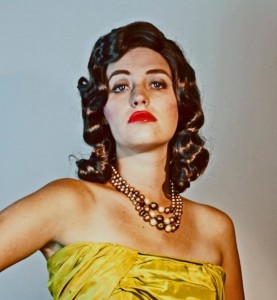
Lenae Day, “Victoria Prescott starring as Dolores Revere in Little Darlings, 1980″ (2013) (all images courtesy Mark Moore Gallery unless otherwise noted)
LOS ANGELES — Once in awhile, we all think about it, though some of us admittedly more than others: What’s it like to be a movie star? How would I look on the cover of a magazine, on a movie poster, on celluloid, in the tabloids, as a doll, as a picture to hang on the wall? How does it feel to have random people you don’t know idolizing you and your “glamorous life,” when little do they know that half the day you’re sitting on set, bored, chain-smoking Lucky Strikes and putting them out in a silver ashtray, both of which will one day become celebrity memorabilia? When it comes to celebrities, it doesn’t make too much of a difference what’s real and what’s speculation, because everything is part of the same glorified fantasy space. At least, that’s what Lenae Day’s clever solo exhibition Prescott Pictures, at Mark Moore Gallery, would have you believe.
Fitting perfectly into the gallery’s compact project space, Day’s installation features light pink pillars topped with golden reliefs and tucked into the corners, as well as pink paint and reliefs lining the top edges of the walls, to ensure a vintage feel. This is the one-room museum of the iconic Prescott lineage, which is so famous you’ve probably never heard of them. Priscilla Prescott was a star of the silent film era, starring as a flapper in the 1920s movie Salomé; her granddaughter Tiffany Prescott-Day, who looks strikingly similar to her grandmother, plays both nun and hooker in the 1980s film The Virgin Terri. Priscilla’s daughter, Victoria Prescott, appears in the 1970s flick Cormorants Crossing, which has more of an uncanny “trapped in paradise” feel than the vibe of a sexy disco romance waiting to happen (all of these movies, of course, being fictional). The idea of a matriarchal line of women traveling through eras of film history — really, as archetypes of the same woman in different eras — makes sense considering the way that familial relationships dominate the film industry, where lineages rule.
Read the full review on Hyperallergic: http://hyperallergic.com/105832/daydreaming-of-a-star-youve-never-seen/



